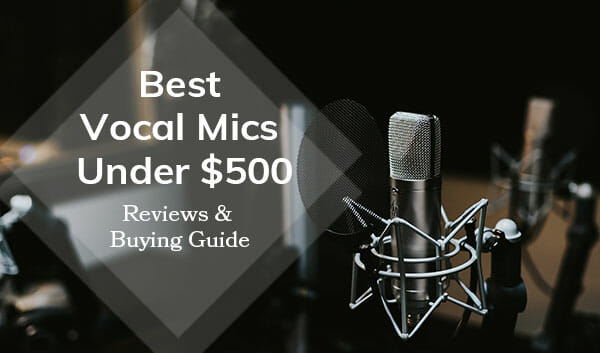
A microphone is the life of the musical, be it a studio recording or a live performance. Artists often seek professional quality microphones that suit their style and stand up to the technical standards.
Many brands of professional sound gears and equipment are rapidly evolving their product portfolio with more affordable versions. With world-class features and design, here is a list of the most desirable professional vocal mics under $500 in 2024.
Table of Contents
- Our Top Picks
- 1. Lauten Audio LA-220
- 2. Warm Audio WA-47jr
- 3. AKG C214
- 4. Shure SM7B
- 5. Shure Beta 181/C
- 6. Rode NT1-A
- 7. Sennheiser e965
- 8. SE Electronics Voodoo VR2
- 9. Cascade Microphones Fat Head II
- FAQs About Best Vocal Mics under $500
Our Top Picks
- Best Overall: Rode NT1-A
With a very low self-noise, great features and basic accessories included in the package, the Rode NT1-A is a top-quality home studio microphone. - Best Versatility: Warm Audio WA-47jr
WA-47jr from Warm Audio has three in-built polar pattern options making it the most versatile vocal microphone under $500. - Best Condenser Microphone: AKG C214
AKG C214 is a well engineered condenser vocal microphone with reliable filters. - Best Dynamic Microphone: Shure SM7B
It is packed with top features and generates exceptional sound output. - Best Ribbon Microphone: SE Electronics Voodoo VR2
It delivers the ultimate sound experience by combining smoothing ribbon effect and high-end extension.
Top Reviews of Vocal Mics Under $500 in 2024
1. Lauten Audio LA-220
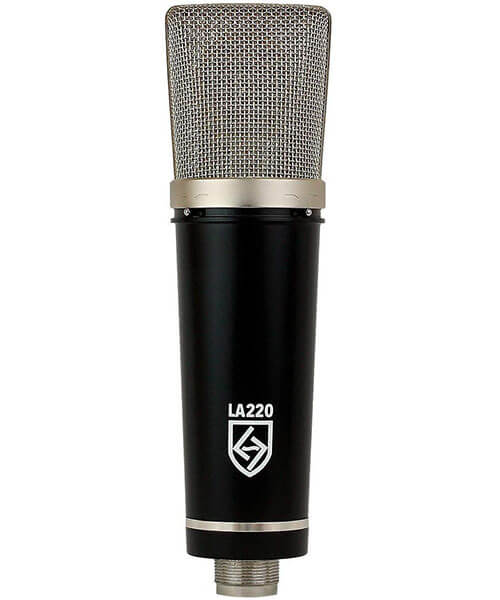
Lauten Audio LA-220 has received rave reviews worldwide. This large diaphragm microphone offers great versatility and professional studio recordings. The masterfully designed high-cut and low-cut filters on the microphone make the vocals stand clear above any disruptive sources or rumbles.
The spider shock mount included with the microphone lends superior isolation from vibrations. Its Junction Field Effect Transistor yields superior sonic and balanced output.
Specifications
- FET Condenser Microphone.
- Cardioid pattern.
- 1″ pressure gradient capsule.
- 12 kHz high-cut filter and 120 Hz low-cut filter.
- 15dB (A weighted) self-noise level.
- Works on 48 volt phantom power.
Pros
- Versatile functioning suitable for vocals and acoustics.
- Reliable dual filters.
Cons
- Lacks pad control.
The best professional studio microphone for beginner artists.
2. Warm Audio WA-47jr
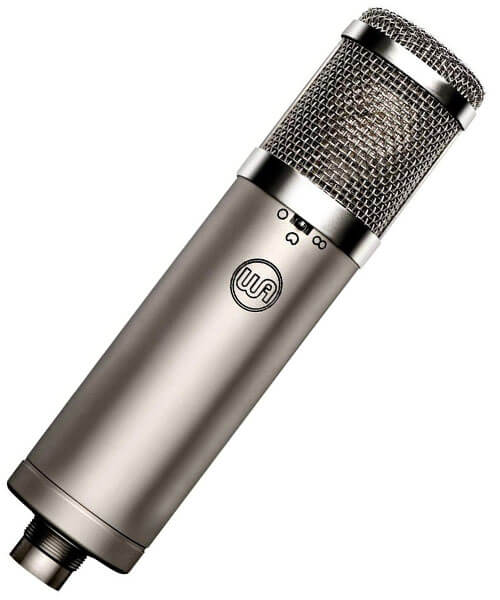
Regarded as one of the most desirable microphones in the budget category, the Warm Audio WA-47jr is a transformer-less version of the ’47 style microphones. Besides the impeccable vintage design, the WA-47jr comes with three polar patterns and incredible versatility.
It has low self-noise and discrete signals. The FET condenser microphone is fitted with quality capacitors which give a solid sound for vocals, percussions, and acoustics. This is a dual diaphragm microphone with just the perfect low, mid and high ranges for a beautiful natural recording.
Specifications
- FET condenser microphone with dual large diaphragm.
- Cardioid, Figure-of-Eight and Omni-directional polar patterns.
- K47 style capsule.
- 9dB (A- weighted) self-noise level.
- 70 Hz high-pass filter.
- Works on 48-volt phantom power.
Pros
- Shockmount, hard mount and -10db pad are included in the package.
- The three polar patterns offer much flexibility.
Cons
- The high-pass filter is very mild and at times brings only barely noticeable impact.
The Warm Audio WA-47jr is the only vintage style all-rounder microphone at a highly affordable price.
3. AKG C214

AKG launched the C214 model as an affordable version of its high-end model C414. This microphone boasts significantly reduced noise and vibrations, and clear detailed vocal recordings.
At under $500, you can get the sonic character of high-end professional microphones. With its dynamic range and bass-cut filter, the microphone allows users to record flawless vocals at close-up level. This microphone is suitable for vocals, solo instruments, and radio and theatre performances.
Specifications
- Large diaphragm condenser with patented black-plate technology.
- Cardioid polar pattern.
- 20 Hz to 20kHz frequency.
- 160 Hz high pass filter that cuts bass.
- Switchable low pass filter reduces rumble and wind noise.
- 13dB (A weighted) self-noise.
- 9 to 52 volt power required.
Pros
- Clear natural sound ideal for vocals.
- Shock mount and pad are included in the purchase.
Cons
- The highs can sound too bright and need some practice to get the vocals adjusted.
AKG C214 offers absolute fidelity and very low self-noise, which sounds great in most environments.
4. Shure SM7B
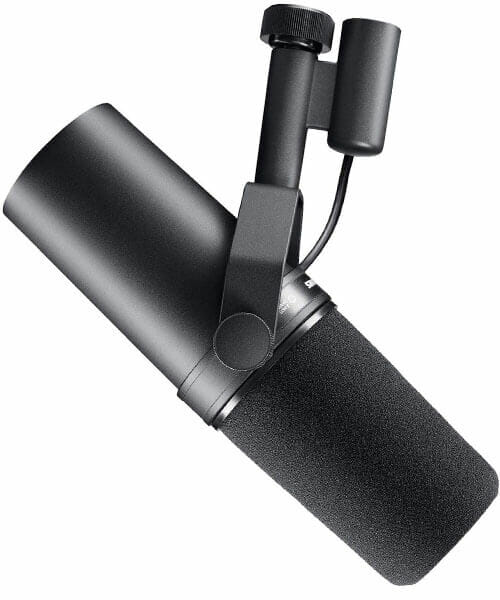
The SM7B from Shure is a dynamic vocal microphone with a cardioid polar pattern. The microphone possesses a dual-band and switchable passive EQ, which offers low cut and mid-range emphasis.
The built-in air suspension shock isolation and pop filter reduce most distortions and noise. The advanced shielding optimizes the sound quality and rejects any computer hum or instrument interference.
The microphone comes with a windscreen that perfectly captures close-up vocals and sound. Wide-range frequency response and the dynamic cartridge of the microphone deliver crisp and natural sound.
Specifications
- Dynamic microphone.
- Cardioid polar pattern.
- 50 Hz – 20 kHz frequency.
- 180 dB maximum sound pressure level (SPL).
- Air suspension shock isolation.
- Dual tone control and pop filter.
- 48 volt phantom power required.
Pros
- Windscreen, mounting bracket and switch cover plate are included in the package.
- The 180 dB SPL is ideal for powerful bass drums and similar instruments.
Cons
- The microphone needs to be supported with a signal booster and pre-amplifier.
The dynamic characteristic of Shure SM7B is the best choice for voice-over applications.
5. Shure Beta 181/C
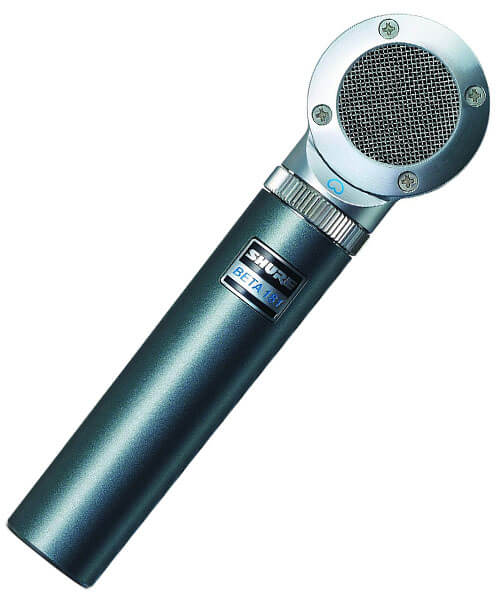
Shure has brought about its ultra-compact revolutionary design with this small diaphragm condenser microphone. The microphone captures impeccable and accurate sound even at side-address. The cardioid condenser microphone can be conveniently interchanged with other polar patterns when required.
The compatible capsules sold separately come in super-cardioid, omnidirectional and figure-of-eight options. The microphone performs reliably even at very high sound pressure levels.
Specifications
- Small diaphragm condenser microphone.
- Cardioid polar pattern.
- 150 dB maximum sound pressure level.
- greater than 20 dB (A-weighted) self-noise.
- Works on 48-volt phantom power.
Pros
- Convenient side-address is a huge advantage over other front-address condenser microphones.
- Option to replace the capsules for a different polar pattern.
- Windscreen included in the package.
Cons
- The self-noise rating renders the microphone is intended only for loud-sources and stage ambiance where the noise floor is not very prominent.
Shure Beta 181/C is practical, compact and durable – ideal for live performances.
6. Rode NT1-A
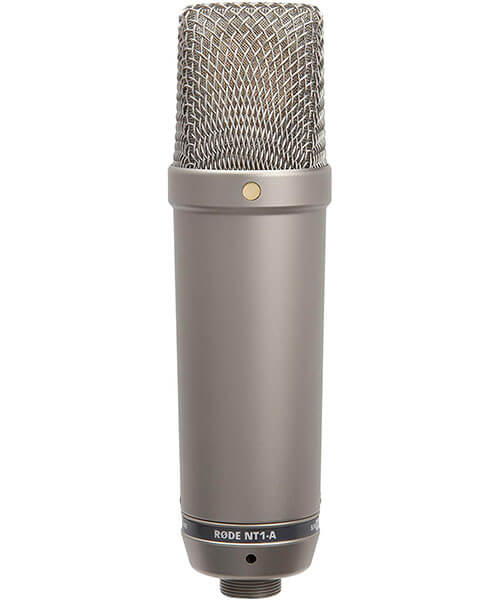
Known as the world’s quietest professional microphones, the Rode NT1-A is a large-diaphragm cardioid condenser microphone. With a nickel-plated satin finish, the microphone looks very premium.
At a very affordable price-point, the Rode NT1-A shelves a high maximum sound pressure level and wide frequency response. The package includes necessary accessories like shock-mount, pop filter and cable, which completes the set-up for a basic home studio recording.
Specifications
- Large gold plated diaphragm.
- 1″ pressure gradient capsule.
- Cardioid polar pattern.
- 20 Hz t0 20 kHz frequency range.
- 5 dB (A-weighted) self-noise level.
- Internal capsule shock mounting.
- 48-volt phantom power required.
Pros
- Ultra-low self-noise.
- Shock mount, pop filter and 20 feet cable included in the package.
- 10 year extended warranty option.
Cons
- Rode NT1-A requires the support of a good pre-amplifier.
Rode NT1-A has negligible noise, offers great versatility and a superior dynamic range.
7. Sennheiser e965
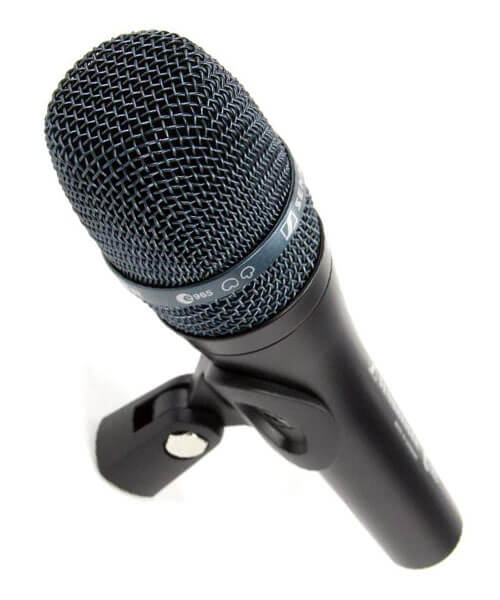
Priced at the higher-end among other affordable options, the Sennheiser e965 offers the perks of more expensive microphones. The microphone not only captures details and accurate sounds but also supports the tough handling of a live performance.
The mid-range sounds impressively polished and warm on this microphone. The large-diaphragm microphone yields a sharp balanced output. Users can switch between polar patterns, and a -10 dB pad. These features make the Sennheiser e965 a very versatile microphone.
Specifications
- Dual diaphragm.
- Externally biased condenser.
- Cardioid and super-cardioid polar patterns.
- 40 Hz to 20 kHz frequency range.
- 142 dB maximum sound pressure level.
- 21 dB (A-weighted) self-noise.
- 10-year warranty.
Pros
- Shock-mounted capsules deliver very crisp and dynamic sonic quality.
- Low-cut filter helps eliminate noise and rumble.
Cons
- The self-noise level at 21 dB is not very impressive.
Sennheiser e965 is sensitive to the source with minimal distortions and yields very impressive clear vocals.
8. SE Electronics Voodoo VR2
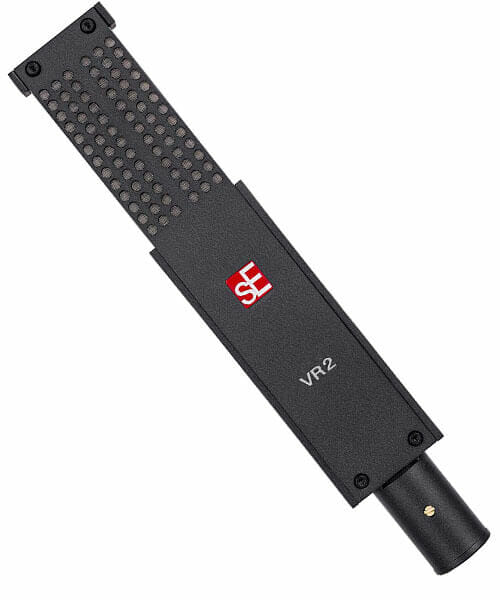
SE Electronics Voodoo VR2 introduces an extended high-end to usual the smoothing effect of a ribbon microphone, using a unique mechanical diffuser method. The specially designed transformer and active circuitry makes the Voodoo VR2 a good microphone for vocals as well as acoustics.
With a sleek look and handcrafted ribbon element, this is one of the finest looking and best performing ribbon microphones at an affordable price.
Specifications
- Active ribbon microphone.
- Figure-of-Eight polar pattern.
- 20 Hz to 18 kHz frequency range.
- 20 dB self-noise.
- 135 dB maximum sound pressure level.
Pros
- The in-built active circuitry yields reliable and detailed sound.
- Shock-mount included in the package.
Cons
- The delicate ribbon design is not suitable for rough handling.
The Voodoo VR2 is a remarkable innovation in terms of the high-end extension in a ribbon microphone.
9. Cascade Microphones Fat Head II
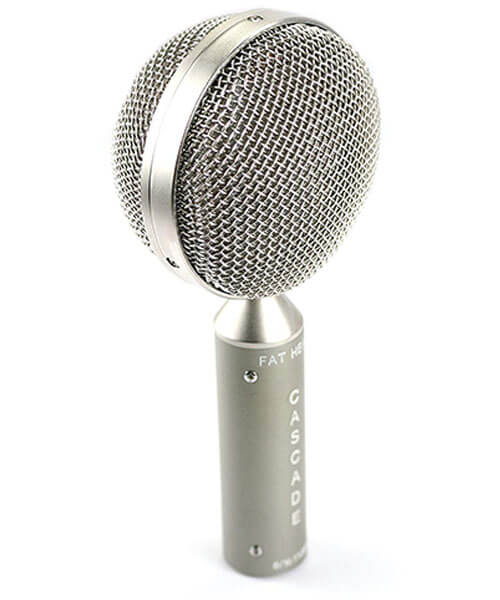
With a polished design and a hand-built ribbon element, the newer version of Fat Head from Cascade Microphones is a very attractive microphone. The balanced input signal on both sides of the ribbon, this microphone yields an iconic “fat” sound.
The brass body of the microphone lends it greater durability and facilitates noise isolation. The Fat Head II is one of the most preferred microphones for vocals, percussion, acoustics and guitar.
Specifications
- Ribbon microphone.
- Lundahl LL2913 Transformer.
- Figure-of-Eight polar pattern.
- 135 dB maximum sound pressure level.
Pros
- Brown and gold-plated body looks exquisite and classic.
- Superior sound and clarity.
Cons
- You need to shell out a few extra bucks for the shock-mount.
Fat Head II is one of the highly acclaimed ribbon microphones for achieving warm dense sound at an affordable price.
Top Brands: Vocal Mics Under $500
Here are some of the best brands that manufacture premium quality vocal mics for professionals.
- Lauten Audio
Lauten Audio is a trusted brand for high-end professional studio microphones. The brand is well known for passionately designed and high-quality products.
- Warm Audio
Warm Audio is a relatively young enterprise with a mission of delivering high quality professional sound gears at affordable prices. The company has successfully revealed several renditions of classic style audio instruments over the past years.
- AKG
AKG by Harman is one of the world’s leading manufacturers of top-quality microphones, and sound equipment. It has made its mark in the world of professional audio instruments by consistently delivering innovation and quality.
- Shure
Shure is a brand driven by the zeal for impressive and immersive sound experience. Since 1925, the company has consistently rendered outstanding sound gears and gained global fame.
- Rode Microphones
Rode Microphones entered the market in 1990 and has progressively achieved world-class quality standards. It is a trusted brand for high precision gears at affordable prices.
- Sennheiser
Sennheiser is regarded as one of the oldest and best brands for high-end microphones. The company offers a 10-year warranty on the high-end products.
FAQs About Best Vocal Mics under $500
How to select the best microphone for lead vocals?
The best microphone for lead vocals is the one which yields the most natural sound with least distortions, and suits the singer’s personal style.
Which vocal microphone under $500 is suitable for stage or live performances?
Sennheiser e965 and Shure 181/C are the best vocal microphones under $500 suitable for stage and live performances.
What is the main purpose of a condenser microphone?
Condenser microphones capture natural and clear sound along with the room ambiance. They are suitable for recording from a distance.
What is the main purpose of a dynamic microphone?
Dynamic microphones capture clear sound at high volume levels, and are mostly used for recording pop and rock music vocals, voice over and loud instruments.
What is the main purpose of a ribbon microphone?
Ribbon microphones are classic style microphones which lend a rolling-smooth retro effect to vocals.
Which microphone is suitable or close-miking?
A microphone with a cardioid polar pattern will be suitable for close-miking.
Which microphone is suitable for proximity effect in recordings?
A microphone with a cardioid polar pattern is suitable for the proximity effect and deep vocal tone.
Which microphone is suitable for loud sound recordings?
Dynamic microphones are suitable for loud sound recordings because of their high maximum sound pressure level.
Which type of diaphragm is suitable for studio recording?
Large diaphragm is more accurate and considered suitable for studio recordings.
What is the power supply required for vocal microphones?
Condenser microphones require a 48-volt phantom power supply. Dynamic and ribbon microphones do not require external power supply.
What does maximum SPL mean?
Maximum sound pressure level means the loudest sound that a microphone can handle.
Conclusion
Our list of best vocal microphones under $500 recommends the most affordable options suitable for studio recording as well as live performances. Most of these are technologically advanced, versatile and durable.
A wise choice may help you skip an upgrade for the next few years and save a good lot of money.

